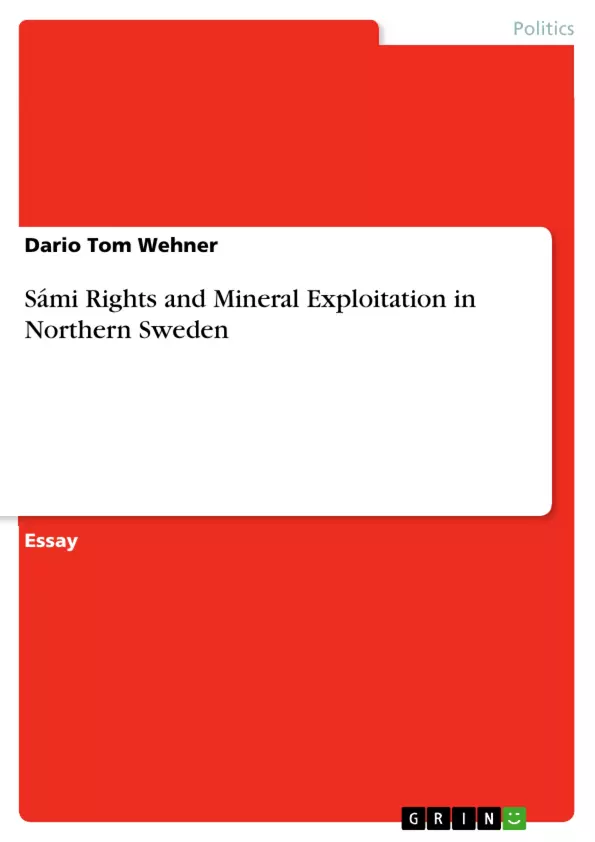In Sweden, known for high quality of life, freedom, and gender equality, concerns arise regarding the treatment of its indigenous Sámi population, particularly in mineral-rich northern Sweden (Sápmi). Despite Sweden's international human rights reputation, scholars highlight issues in recognizing the Sámi as a distinct Indigenous group. The focus on mineral exploitation in Sápmi, inhabited and used by the Sámi, reveals a contentious situation. The paper investigates if Sámi people face discrimination in mineral exploitation, considering their land claims based on indigeneity and reindeer husbandry. While Sweden pursues mineral access, the paper questions the fairness of treatment and explores whether Sámi people merit special rights. The analysis extends beyond mineral exploration, shedding light on Sweden's treatment of indigenous peoples. Divided into three parts, the paper evaluates contemporary research, assesses potential discrimination against the Sámi, and concludes that while Sweden may not discriminate in mineral mining, it falls short in recognizing the Sámi as an indigenous people.
Inhaltsverzeichnis (Table of Contents)
- Introduction
- A short Literature Review
- Sámi in Sweden
- Sámi Self-Determination
- Laws and Regulations
- The Case of Mineral Mining in Swedish Sápmi
- On Equality
- Special Needs and Special Rights
- Conclusion
Zielsetzung und Themenschwerpunkte (Objectives and Key Themes)
The main objective of this paper is to investigate whether the Sámi people in Sweden experience discrimination in regards to mineral exploitation in Swedish Sápmi. The paper will analyze if the Sámi are treated equally to other stakeholders in this context and whether their unique needs and status as an indigenous group warrant special rights and protections regarding mineral exploration and exploitation.
- The impact of mineral mining on the Sámi population in northern Sweden, particularly their traditional reindeer husbandry.
- The legal framework governing Sámi rights and the degree to which it effectively protects their interests.
- The need for special rights and protections for the Sámi people, considering their unique cultural and economic dependence on the land.
- The potential for a power imbalance in stakeholder conflicts due to limited resources within Sámi institutions.
- The broader implications of Sweden's treatment of indigenous peoples and minorities in relation to mineral exploitation in Swedish Sápmi.
Zusammenfassung der Kapitel (Chapter Summaries)
- Introduction: This chapter introduces the context of the research question, highlighting Sweden's positive standing in international rankings while contrasting it with concerns surrounding the treatment of the Sámi population. It focuses on the case of mineral mining in Swedish Sápmi, its significance, and the need for further investigation beyond existing research.
- A short Literature Review: This section provides a comprehensive overview of existing research on the Sámi people in Sweden, covering various fields like education, health, indigenous rights, legal aspects, and mineral exploitation. It reveals common themes of concerns regarding Sweden's treatment of the Sámi as a distinct indigenous group and its reluctance to ratify international conventions.
- Sámi in Sweden: This chapter explores the demographic and socio-cultural context of the Sámi in Sweden, outlining their history, distribution, and involvement in reindeer husbandry through the Samebyar system. It also discusses the recognition of the Sámi as an indigenous people and the potential challenges faced by non-reindeer herding Sámi in terms of representation.
- Sámi Self-Determination: This section will delve into the concepts of Sámi self-determination and its relevance to the context of mineral exploitation in Swedish Sápmi. It will explore the legal and political frameworks surrounding Sámi autonomy and rights within the Swedish state. This includes examining the roles of the Sámi Parliament (Sámediggi) and the existing legal mechanisms for protecting Sámi interests.
- Laws and Regulations: This section will examine the legal framework governing Sámi rights in Sweden, analyzing the extent to which international conventions have been implemented domestically. It will also discuss the effectiveness of existing laws and regulations in protecting Sámi interests, particularly in relation to mineral exploration and exploitation.
- The Case of Mineral Mining in Swedish Sápmi: This chapter will analyze the specific case of mineral mining in Swedish Sápmi, examining its impact on the Sámi population, especially reindeer herding. It will explore the conflicting interests between the Swedish government's desire for mineral resources and the Sámi people's dependence on the land for their traditional livelihoods.
- On Equality: This section will evaluate whether the Sámi are treated equally to other stakeholders in relation to mineral exploitation in Swedish Sápmi. It will assess the existing legal and administrative frameworks for determining access to land and resources, examining whether these mechanisms provide fair and equitable treatment for all parties involved.
- Special Needs and Special Rights: This section will discuss the potential need for special rights and protections for the Sámi in the context of mineral exploitation. It will explore the arguments for and against such special considerations, taking into account the Sámi people's unique cultural and economic dependence on the land, their status as an indigenous group, and the potential for power imbalances in stakeholder conflicts.
Schlüsselwörter (Keywords)
The main keywords and focus topics of this paper include Sámi rights, mineral exploitation, indigenous peoples, Swedish Sápmi, reindeer herding, self-determination, special rights, equality, prior informed consent, international conventions, colonization, and stakeholder conflicts.
- Arbeit zitieren
- Dario Tom Wehner (Autor:in), 2023, Sámi Rights and Mineral Exploitation in Northern Sweden, München, GRIN Verlag, https://www.grin.com/document/1403852



